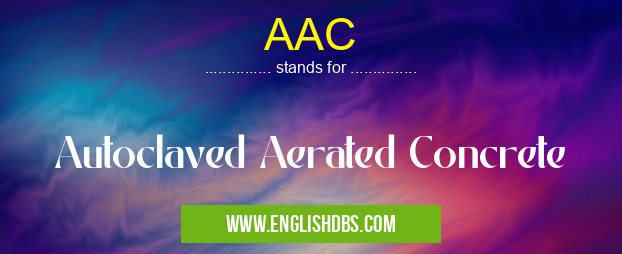What does AAC mean in UNCLASSIFIED
AAC stands for Autoclaved Aerated Concrete, a lightweight, cellular building material. It is a composite material consisting of cement, lime, sand, water, and an expanding agent, typically aluminum powder. The expanding agent causes the concrete to form tiny air bubbles, resulting in a porous and lightweight material.

AAC meaning in Unclassified in Miscellaneous
AAC mostly used in an acronym Unclassified in Category Miscellaneous that means Autoclaved Aerated Concrete
Shorthand: AAC,
Full Form: Autoclaved Aerated Concrete
For more information of "Autoclaved Aerated Concrete", see the section below.
Composition and Manufacturing
- AAC is manufactured by mixing cement, lime, sand, water, and an expanding agent.
- The mixture is then poured into molds and placed in an autoclave, where it is subjected to high pressure and steam.
- During autoclaving, the expanding agent reacts and creates tiny air bubbles, causing the concrete to expand.
- The resulting material is a lightweight, porous, and insulative concrete.
Properties and Benefits
- Lightweight: AAC has a density ranging from 300 to 800 kg/m³, making it significantly lighter than traditional concrete.
- Insulating: The air bubbles trapped within the concrete create excellent thermal insulation, reducing energy costs.
- Fire-resistant: AAC is a non-combustible material, and its porous structure provides resistance to fire penetration.
- Easy to Handle and Install: AAC blocks are lightweight and easily cut and shaped, making them convenient for construction.
- Durable: AAC is a durable material with a long lifespan, and it exhibits resistance to moisture and freezing.
Applications
AAC is widely used in various construction applications, including:
- Walls andPartitions: AAC blocks are commonly used as exterior and interior walls, offering insulation, fire resistance, and sound absorption.
- Roofing: AAC can be used as lightweight roofing insulation, providing excellent thermal performance.
- Flooring: AAC can be used as a subfloor or underlayment, providing a smooth and even surface.
- Landscaping: AAC is used in landscaping applications, such as retaining walls and decorative elements.
Essential Questions and Answers on Autoclaved Aerated Concrete in "MISCELLANEOUS»UNFILED"
What is Autoclaved Aerated Concrete (AAC)?
AAC is a lightweight, precast concrete building material composed of cement, fly ash, lime, sand, and water. It is cured under high pressure in an autoclave, resulting in a porous structure with a high strength-to-weight ratio.
What are the advantages of using AAC?
AAC offers numerous advantages, including:
- Lightweight: AAC is significantly lighter than traditional concrete, making it easier to handle and transport.
- High Strength: Despite its lightweight nature, AAC exhibits high compressive strength, allowing for the construction of tall and robust structures.
- Thermal Insulation: The porous structure of AAC provides excellent thermal insulation, reducing energy consumption for heating and cooling.
- Fire Resistance: AAC is non-combustible and fire-resistant, meeting building code requirements for fire safety.
- Sound Absorption: The porous structure of AAC effectively absorbs sound, creating a quieter and more comfortable living environment.
- Sustainability: AAC is eco-friendly as it utilizes recycled materials and has a lower carbon footprint compared to traditional concrete.
Where is AAC commonly used?
AAC is widely used in various construction applications, such as:
- Residential Buildings: As exterior and interior walls, floors, and roofs
- Commercial Buildings: As office buildings, warehouses, and shopping centers
- Industrial Buildings: As manufacturing facilities and storage units
- Infrastructure Projects: As bridges, tunnels, and noise barriers
How is AAC different from traditional concrete?
AAC differs from traditional concrete in several key aspects:
- Density: AAC is significantly lighter than traditional concrete due to its porous structure.
- Strength: AAC has a lower compressive strength than traditional concrete, but it is still suitable for most construction applications.
- Insulation: AAC provides excellent thermal and sound insulation, while traditional concrete requires additional insulation materials.
- Workability: AAC is easier to work with than traditional concrete, as it can be cut, shaped, and drilled using conventional tools.
- Sustainability: AAC is more environmentally friendly than traditional concrete, as it utilizes recycled materials and produces less carbon emissions.
Final Words: AAC is a versatile and energy-efficient building material with numerous applications. Its lightweight, insulative, and fire-resistant properties make it an ideal choice for various construction projects. The use of AAC contributes to sustainable building practices by reducing energy consumption and environmental impact.
AAC also stands for: |
|
| All stands for AAC |
